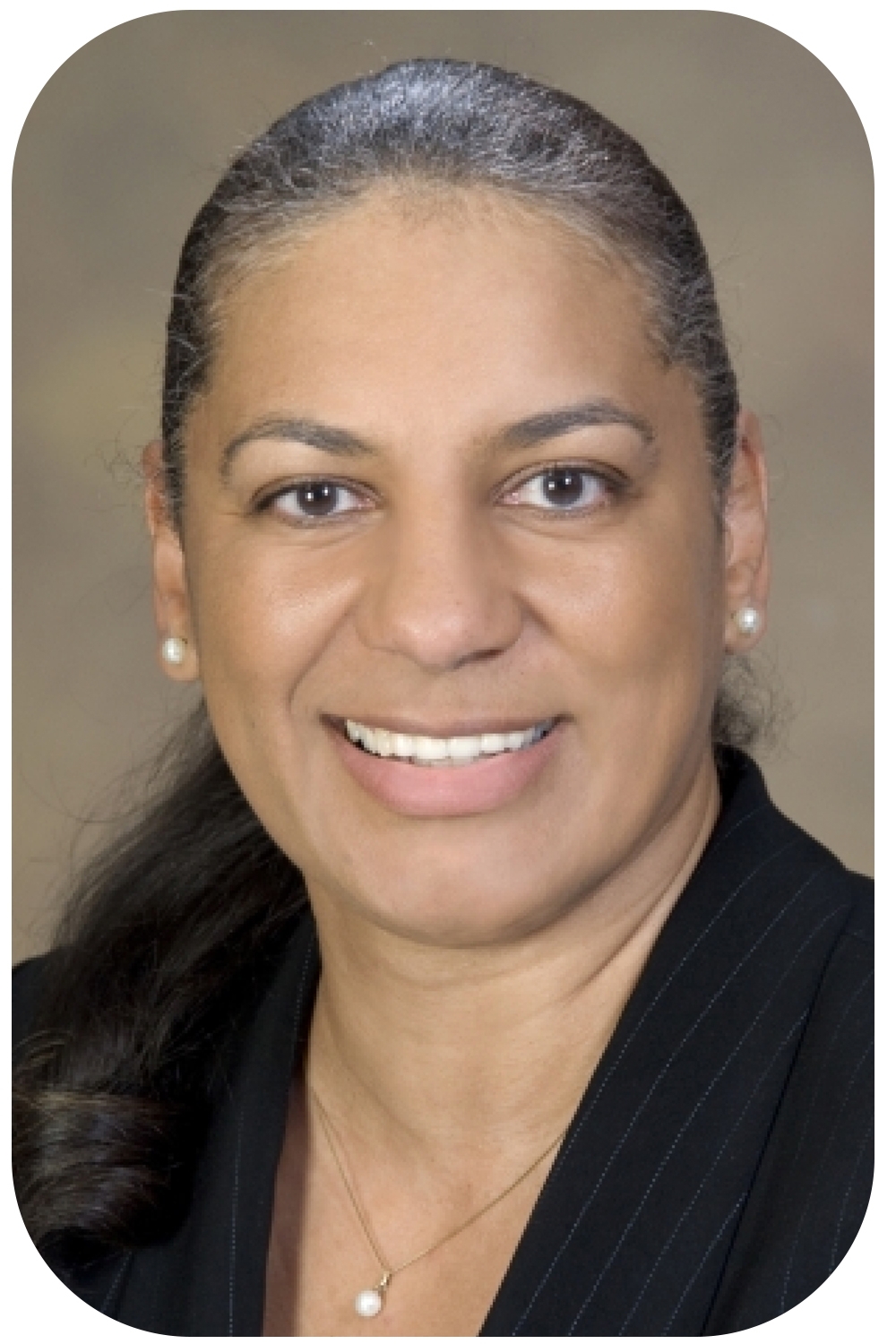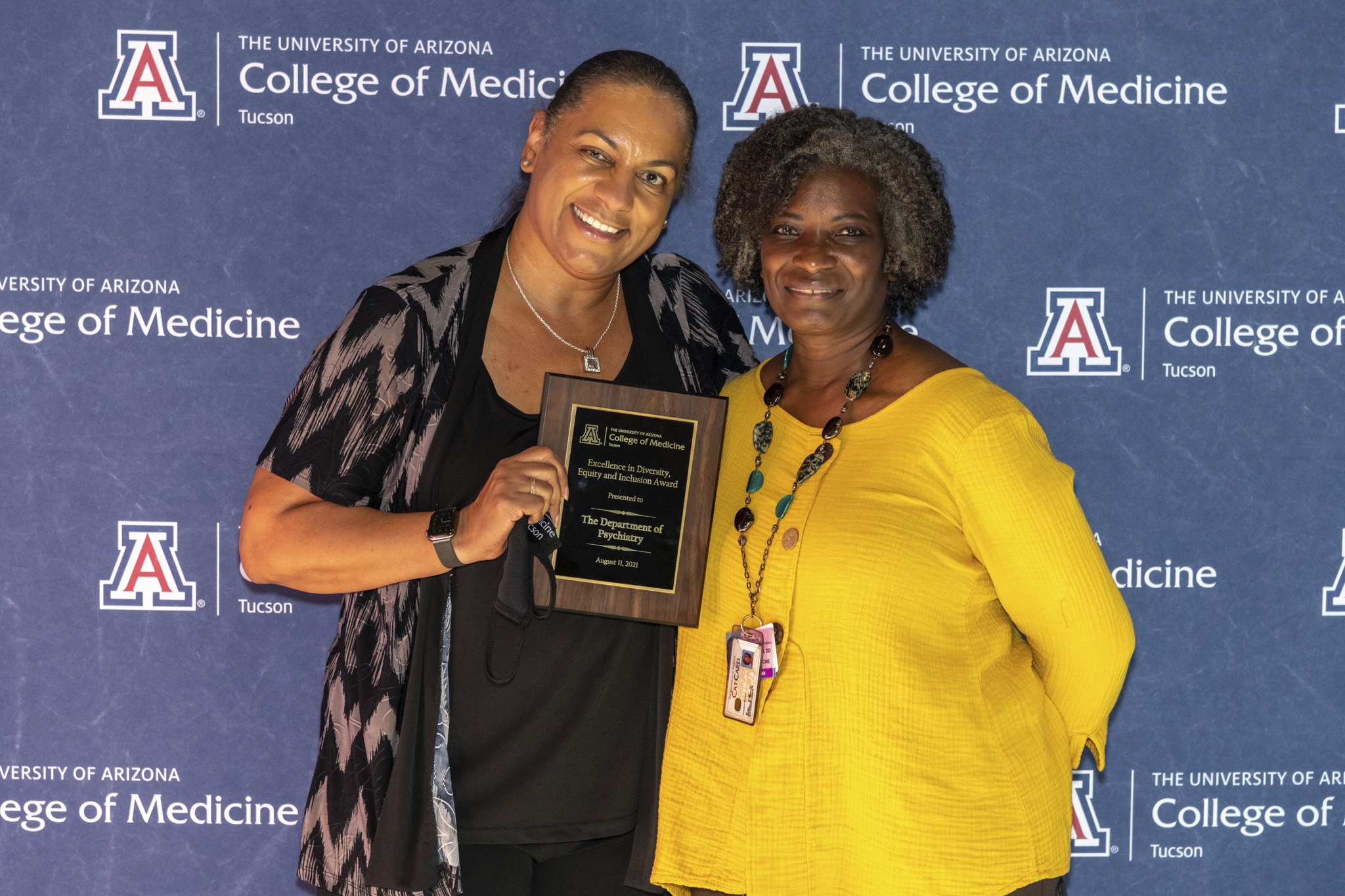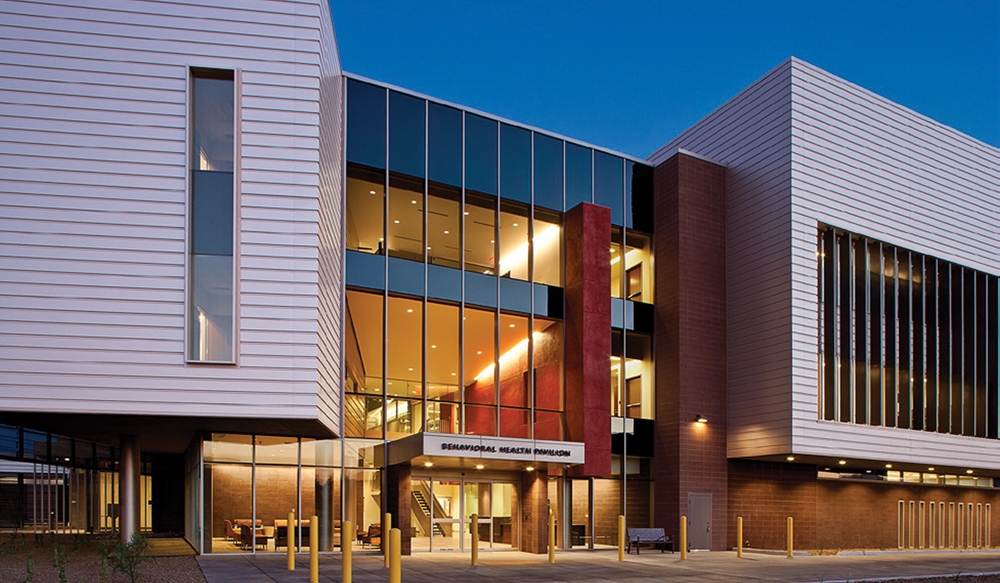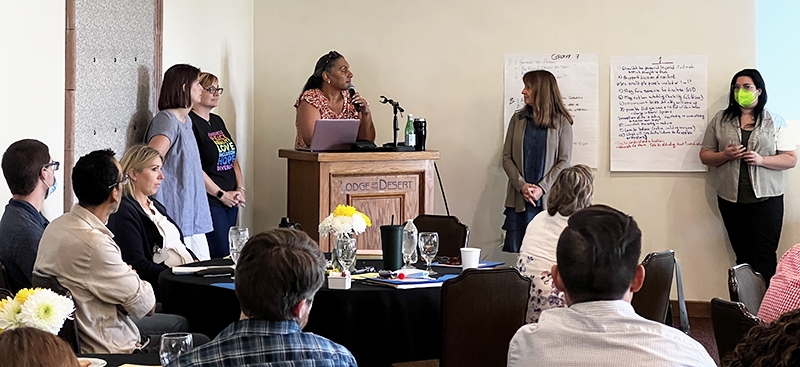
After a career spanning more than thirty years, and the last 18 years with the College of Medicine – Tucson Psychiatry Department, Patricia Harrison-Monroe, PhD, retired at the end of June as the Department’s Vice Chair of Diversity, Equity & Inclusion and as a Clinical Associate Professor.
We talked about the trajectory of her career and life, starting with her academic and professional interests that eventually drew her to Tucson and the Psychiatry Department in 2002.
What initially inspired you to study forensic psychology for your undergraduate degree?
Initially I was a journalism major, but after taking an abnormal psychology class, I realized that I was much more interested in learning more about serious mental illness. I also wanted to get an applied psychology education rather than just a generic psychology degree. One of my first jobs was as a night shift psych tech at a state hospital in New York City (NYC) where I was often assigned to a unit for patients deemed criminally insane, and I became very interested in understanding the intersection of mental illness and the law/criminal behavior. So, I went to school during the day and studied at work when the patients were asleep.
From there, you pursued a PhD in clinical psychology at Columbia University. What academic and social aspects of your studies there inform(ed) your professional career, your academic work, and your personal life?
My time at Columbia was challenging. As the only person of color in my program, and certainly the only one with a job, it was not easy to develop a sense of belonging. Needless to say, issues of diversity of any kind were not addressed during didactics or clinical supervision. When it came time to find a mentor for my dissertation research, my topic concerning self-concept development in biracial children garnered minimal interest and I was advised to seek someone in the Counseling Psychology program, at the time perceived as less rigorous, where they “do that sort of thing.” I did and was surprised to find not only a wonderful mentor, but also a very diverse student body engaged in exciting research. While I still needed an official advisor from my department, I will always remember my mentor from the “other department.”
Many incidents come to mind about inequitable treatment, including being assigned nearly all Black patients in our community training clinic. I didn’t realize that this was not about patient preference, but rather the clinic director’s belief that I would “work better” with them as I could “relate.” That stopped once I pointed out that not only was this impacting my training experience, but also did not necessarily benefit the patients.
I was often mistaken as part of the service or janitorial staff when I would stay late to work on something, but that is not an experience that was relegated to Columbia 30+ years ago. My belonging and legitimacy has been questioned in multiple settings over the years, including here are COM-T.
Once, while attending a senior leadership meeting an attendee whom I had never met said to me, “Be a dear and get me some water.” The department chair overheard, got up and pointedly said, “Dr. Harrison-Monroe, would you like some water?” I was appreciative that he used his position of privilege to intervene, however while the original speaker looked startled, he said nothing else to me.
And, of course, the unwarranted familiarity of the use of my first name by people who don’t know me even if I am introduced as Dr. Harrison-Monroe, is a standard occurrence.
You won numerous outstanding service and leadership awards for your work while living in NYC, along with the Commissioner’s Special Recognition Award for Service in the Aftermath of the World Trade Center Disaster (1/2002). What was the aftermath of 9/11 like for the city and where you worked?
The aftermath of 9/11 was an incredibly traumatic time that is difficult to describe. There were frequent bomb threats toward the Federal building across the street from my office, requiring multiple evacuations, and very retraumatizing for all of us. The streets were blocked off and you had to walk a gauntlet of barricades and pass police with machine guns, showing ID and authorization to be in the area at various checkpoints. While this helped with a sense of security, it was a daily reminder of the reality of what had happened. That, and the pervasive smell of smoke which persisted for many weeks, while the fires continued to burn underground. Then we had the sarin scare at one of the networks and a plane crash at one of our local airports. Each event raising the specter of another terrorist attack.
What services did you provide post-9/11 as the Assistant Commissioner for the New York City Department of Mental Health?
The focus in the initial days was on addressing the needs of families once it was clear that there were very few survivors. The streets around Ground Zero were horrifying. Yet, to help with the grieving process, staff from my office volunteered to escort family members close to areas cleared by police. Just a sense of being near to where their loved ones died was comforting to some extent. It was traumatic for everyone involved, yet there was also a tremendous display of resilience among those tasked to help.
Leadership from all City departments worked closely with the NYC Incident Command and other involved state and federal agencies, and we all took turns to staff the relocated “Bunker.” In my role, I worked closely with various organizations to assess the City’s mental health needs in the immediate aftermath and our projections for longer-term needs by populations – first responders, children, families, friends, and colleagues of those lost, general population affected, as well as those who were already dealing with mental health issues, the homeless, and those who were seriously mentally ill. Each population subgroup needed a different approach and access to various resources.
 My colleagues and I spent much time collaborating with a consortium of agencies on program development and urgent funding requests to the state and federal governments to address the identified needs, expand a multi-lingual mental health hotline, and establish support centers for families searching for loved ones, file death certificates and collect DNA samples. Additionally, the focus was on expanding the overall mental health service system to be prepared to address the expected long-term mental health needs of the millions of New Yorkers affected by this attack.
My colleagues and I spent much time collaborating with a consortium of agencies on program development and urgent funding requests to the state and federal governments to address the identified needs, expand a multi-lingual mental health hotline, and establish support centers for families searching for loved ones, file death certificates and collect DNA samples. Additionally, the focus was on expanding the overall mental health service system to be prepared to address the expected long-term mental health needs of the millions of New Yorkers affected by this attack.
You served on so many committees and boards throughout your career. You’ve given so much of yourself in service to others. Who or what influenced you to give so much of your time and expertise and energy?
I strongly believe that in order to effect change, you have to be willing to do something besides identifying areas of need. Over the years, I have had the opportunity to witness the difference individuals can make, and I decided early on that if I can be of assistance, I will do my best. It is also intrinsically very rewarding.
What brought you to Tucson in the summer of 2002?
Two things really. First, I had an unexpectedly distressing experience one morning going to work when I came out of the subway and smelled smoke. I looked around to see where the fire was and wondered why I didn’t hear any fire engines. It was only then that I remembered that the smoke I smelled was there every day, that Ground Zero was still burning underground, and that the face mask I was wearing was to minimize exposure to the harmful air particles. I had forgotten! I realized then that I too had been significantly affected, although I was unhurt, went to work every day, and did my job to help others to deal with the trauma.
Secondly, my stepfather’s health was declining, and it was easier for my husband and I to move to Tucson, than for my parents to move to NYC. It was quite the culture shock for us, both personally and professionally, but it all worked out in the end!
 What was your role in the creation and building of the Behavioral Health Pavilion? What was the timeframe for that?
What was your role in the creation and building of the Behavioral Health Pavilion? What was the timeframe for that?
Due to my experience of funding and developing a wide variety of both inpatient and outpatient mental health programs as Assistant Commissioner in NY, I was asked to take on the Chief of Behavioral Health Services and be the Department’s lead for the construction of the Behavioral Health Pavilion (BHP), in the spring of 2010. The original inpatient unit on South Campus was a very dark and overcrowded space, the antithesis of a healing environment, reminding me of the state hospital wards I worked on decades earlier. Working closely with the architect, construction crews, the head of the hospital’s facilities department, Emergency Department staff, and Pima County officials, construction of the BHP and expanded emergency room, as well as the Crisis Response Center was completed in 2011. The BHP won several architectural awards and was toured by other state and even foreign country representatives looking to build an inpatient psychiatric facility.
I wanted the inpatient units in particular to address many of the concerns our patients voiced, and give them more privacy, a clean bright space, more programming, while still maintaining a safe environment for patients and staff. The successful transition of our patient services to the state-of-the-art Behavioral Health Pavilion led to a significant decrease in episodes of patient restraints, violence, and injury, as well as to improved patient, staff, and faculty satisfaction. We shuttled all patients individually on golf carts with all their belongings across the campus. I will always remember one patient as he rounded the corner and saw the BHP exclaim, “This is like the Taj Mahal.”
We also constructed the BHP with the surrounding community in mind. I envisioned it to be a welcoming space that did not scream “psych hospital,” so we created a gallery in the large lobby, with rotating exhibits from local artists. We were booked out for the first two years and folks from the neighborhood would come and just sit and look, they would bring their kids on certain evenings when we had staff engage them in fun activities, we provided depression screenings and referrals. The large conference room was also available to the community, and we would give educational talks about mental health open to all and always well attended. Even Pima Community College ran several rounds of an evening semester-long certified technician course there, that several of our own staff participated in, complete with graduation ceremonies. Despite a lot of controversy, the adult outpatient clinic was moved to the BHP from main campus, and with the more recent build-out of the 3rd floor clinic, the child and adolescent outpatient services were also integrated into the BHP.
You also were instrumental to the design and creation of the Whole Health Clinic and the Early Psychosis Intervention Center. What pushed you to create those clinics?
With the increased focus on integrated care, I represented the Department on a State-wide taskforce to develop an integrated care model for the State’s public mental health system and eventually was asked to serve on the Request for Proposals selection committee during 2013/2014.
For many years, I was dismayed by psychiatry being the only specialty that did not accept patients on AHCCCS (Medicaid) for outpatient treatment services. There were many logistical problems, in part due to the way public mental health services are funded in Arizona, but it was clearly an area that needed to be addressed. Particularly being so involved in creating a better state-wide treatment model, it only made sense that we should create our own integrated care clinic. Additionally, an issue often raised by behavioral health patients was their reluctance to access medical care because they often felt stigmatized and discriminated against. Many medical providers were uncomfortable treating someone with a known mental illness or thought patients were less likely to be treatment compliant. So, in collaboration with the then chair of the Department of Family and Community Medicine, we set out to create a mental health clinic with all basic medical services including labs available on site, instead of the more common model of a medical clinic that had the support of an embedded social worker. Much time was spent identifying an appropriate, easily accessible site, create policies and procedures, obtain licensing, and hire staff that fully supported an integrated service model. And, we only hired medical staff who clearly wanted to work in a mental health clinic.
It was a challenging time to start such a project, given the simultaneous merger with Banner Health. Starting a new clinic was of course not their top priority in 2014/2015, however with some delay we were able to get the needed support and opened the clinic in the fall of 2015. Next to getting the BHP built, the creation of the Whole Health Clinic is what I am most proud of. It had its expected growing pains, but over the past eight years it has become a thriving outpatient integrated care clinic, meeting the mental health and physical health needs of the community. It is also the home of the EPICenter, which for many years was the only outpatient clinic in Arizona providing comprehensive mental health services to youth and their families in the early stages of a psychotic illness.
In addition to teaching, serving on numerous COM-T committees, doing collaborative research, serving on community boards, and seeing patients in your private practice, you also provide counseling to medical students. Why was/is it important to you to also serve the medical students studying at UA?
Recognizing the tremendously high-risk group medical students present, it made sense to me to join the existing small group of providers and offer support. For many, getting into medical school is just the start of a long journey that is stressful beyond their expectations and can lead to very serious consequences. For those who are under-represented in medicine (URiM) or first-generation college graduates, the challenges of adapting to the highly competitive and individualistically focused culture of academic medicine can be especially overwhelming. Over the years, helping students of all backgrounds has been rewarding, seeing them grow and overcome obstacles, with many staying in touch past graduation and some even post residency.
I strongly believe in our responsibility to provide medical students with mental health support, not just during times of crises, but also when they are starting to experience distress, when they need to voice their doubts about belonging, talk about loneliness, or their concerns about not meeting their partner’s or family’s expectations. It is our obligation to support them to the best of our abilities, helping them to stay on track, but also helping them to recognize when they may need to pause. While I know that some believe in the sink or swim, survival of the fittest approach to medical school, I have seen the impact support can have on fostering resilience, learning how to tread water while gathering strength to swim, and the benefits of learning to live, not just survive.
 As the Vice Chair of Diversity, Equity & Inclusion for the Psychiatry Department, you oversaw the Psychiatry Diversity Advisory Committee volunteers, several faculty/staff DEI retreats, coordinated Spark lectures for the Department, created the DEI strategic plan, as well as serving on numerous COM-T committees relating to equity work relating to URiM and addressing bias in many different avenues, including for admission selection committees within the College. Can you share some of the impact your work had on both the department and COM-T?
As the Vice Chair of Diversity, Equity & Inclusion for the Psychiatry Department, you oversaw the Psychiatry Diversity Advisory Committee volunteers, several faculty/staff DEI retreats, coordinated Spark lectures for the Department, created the DEI strategic plan, as well as serving on numerous COM-T committees relating to equity work relating to URiM and addressing bias in many different avenues, including for admission selection committees within the College. Can you share some of the impact your work had on both the department and COM-T?
Most of my career, I’ve been the first black woman in the job, the only one in the room, at the table. And although that was often uncomfortable, I do think that it continued to motivate me to see that number grow. I think my impact is that I showed it was possible to those who need persuasion. I often stress that I do not represent all Black people, I am not their spokesperson, but I also know that those who doubt, will gladly see my failures as representative. And so, I try to limit my failures.
In DEI work, I know that there is often the reference of not just sitting at the table but being invited to the meal. I certainly agree with that, but it starts with getting to the table. During my career, I have taken a seat when the opportunities presented themselves, and I spoke up and out. And although I could not always change people’s minds, it prevented folks from being able to pretend they didn’t know. I loved being able to bring more of a DEI focus to the Department and through my committee work, to COM-T. Being a part of the decision process about who gets a chance to become a physician is a heavy responsibility that affects not just the student, their family, and the institution, but the thousands of future patients who are waiting for their doctor to make a difference in their lives.
What aspects of your career and service while in Tucson are you most proud of?
A big one would be my first role with the Department when I was recruited to lead the Department’s efforts to develop and strengthen mental health services for detained youth at Pima County Juvenile Court through a county contract awarded for medical and behavioral health services. I had the opportunity to help develop a training curriculum for custody staff on more effective ways to interact with detainees with mental health issues. That curriculum was adopted state-wide, and I was able to travel around Arizona and train detention officers and various court staff. Additionally, in collaboration with court administration, I was privileged to lead efforts to reduce disproportionate minority contact with law enforcement funded through the McArthur Foundation and the Annie E. Casey Foundation and educated the judiciary about appropriate and equitable alternatives to detaining non-violent youth. By significantly reducing the numbers of detained youth from over 200 when we first started this effort to under 50, the lives of many primarily minority youth were given the opportunity of a different trajectory, and Pima County Juvenile Court was acknowledged nationally as a model court.
Of course, as I mentioned before, I am proud to have been a part of providing our community with a more humane and healing environment through the BHP and the creation of the Whole Health Clinic. The increased focus on DEI initiatives at COM-T over the past several years has given me hope that despite current national trends, some seeds have been planted that will make the institution and particularly our department more resilient and proactive in confronting discrimination, willful exclusion, and become a more welcoming environment for our students, faculty, staff, and patient population.
What aspects of your career and service while in NYC are you most proud of?
In New York, most of my efforts were focused on at-risk populations, including homeless and exploited youth, the incarcerated mentally ill population within the NYC correctional system, and the diverse communities of Queens and the Bronx for whose public mental health services I was principally responsible during my tenure with the NYC Department of Mental Health. It was the start of my focus on reducing the stigma of mental illness among the general population through outreach and education, and also hopefully conveying that asking for help is a sign of strength, not weakness.
Are there specific seminal moments in your life that were notable for their impact on your life and/or career trajectory?
As an undergraduate, I remember a professor scoffing at my stated goal of going on for my PhD, saying he thought it highly unlikely that I would “stick it out,” citing the limited number of African Americans with a PhD and questioning why I thought I was different. I do not remember his name, but I know that his expressed racism made me even more determined to succeed.
What do you think you will miss most and why?
I will miss the people who have had an impact on me, who have supported me, stood up with me, and who have helped me see my blind spots. I will also miss the opportunities to encourage others striving for recognition and success within COM-T.
What will you miss least/are happy to step away from and why?
One of my frustrations over the years has been the slow pace of systemic change. Even when the evidence is there and all agree that change would be positive, it may not happen in a timely fashion to maximize the benefit. I won’t miss that.
What else would you like to share?
I know this may sound a bit trite, but retiring for me is not the end, but truly just a new opportunity to continue on my path.

